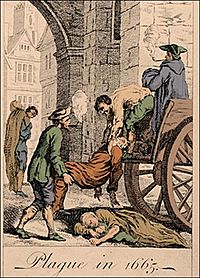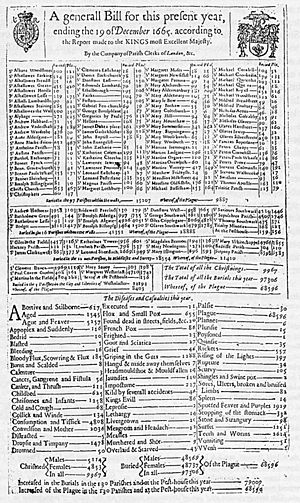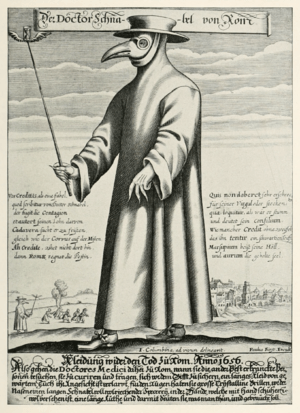Great Plague of London facts for kids

Collecting the dead for burial during the Great Plague
|
|
| Details | |
|---|---|
| Disease | Bubonic plague epidemic |
| Dates | 1665-1666 |
| Spread by | Fleas who bit infected rats, then bit people |
| Victims | |
| Deaths | About 100,000 (1/4 of London's population. |
| Killed more of England's population than World War I or World War II. |
|
The Great Plague of London was a terrible disease outbreak. It happened in London, England, from 1665 to 1666. The disease was called the bubonic plague.
During this time, about 100,000 people in London died. That was almost one-quarter (one out of every four) of London's population. In September 1665, the plague was at its worst. It killed 7,165 people in just one week.
The outbreak finally ended around September 1666. The Great Fire of London, which happened then, might have helped. The fire destroyed many rats and fleas that were spreading the plague.
Most people who died lived in London. But the plague also killed people in other parts of England. By the end, about 2.5% of England's total population had died. This was more than the percentage of people who died in England during World War I or World War II.
Contents
What was the Great Plague?
The Great Plague of 1665 was the last big plague in England. Before this, England had plague outbreaks every few decades. For example:
- The 1603 plague killed 30,000 Londoners.
- The 1625 plague killed about 35,000 people.
- The 1636 plague killed about 10,000 people.
Historians believe the plague came to England from the Netherlands. Dutch trading ships carrying cotton from Amsterdam might have brought it. Amsterdam had a bad plague outbreak in 1663–1664. About 50,000 people died there.
In London, the plague first appeared in the dock areas. These were outside the main city. It also hit the area of St Giles in the Fields. In these places, poor workers lived very close together. Their living conditions were not good.
We don't know how many very poor people died. Their deaths were not always recorded. But records show the first person to die of the plague in London was Rebecca Andrews. She died on April 12, 1665.
How did the plague affect London?
By July 1665, the plague had reached the city of London itself. Many people who had money left the city. They went to the countryside. King Charles II of England, his family, and his court moved to Oxfordshire.
Most wealthy merchants and professionals also left. This meant most businesses closed down. As the plague got worse, more and more people left. London became so empty that grass started to grow in the streets.
However, most of the city's government officials stayed. The Lord Mayor of London, Sir John Lawrence, also stayed. A small number of clergymen, doctors, and apothecaries chose to stay too. Also, people who were too poor to move had to stay in the city.
Some people who stayed wrote about their experiences. Samuel Pepys kept a diary. It gives historians a lot of information about what the plague was like. Henry Foe, a saddler, also stayed in East London. Years later, in 1722, his nephew Daniel Defoe wrote A Journal of the Plague Year. This was a story about the plague. It might have been based on Henry Foe's journals.
How did people react to the plague?
People in London tried many things to stop the plague. They did not understand what caused it or how it spread. They also did not know how to treat it. Antibiotic medications, which can treat plague today, would not be discovered for 300 more years.
People were very scared of catching the plague. They quickly buried the bodies of those who died. They put many bodies together in large pits. In one area of London, 1,114 people who died from the plague were buried together. They were put in a hole 50 feet long and 20 feet wide.
As the plague got worse, people sometimes acted cruelly. Some refused to help sick family members. Others forced sick servants to leave, even if they had nowhere to go. If one person in a home got the plague, the whole family had to stay inside. A red cross and the words "Lord have mercy upon us" were painted on their door. Samuel Pepys wrote in his diary that the plague made people "cruel as dogs to one another."
Government officials tried to stop the plague from spreading. They started several public health programs:
- They hired doctors.
- They ordered large fires to burn day and night. They hoped this would clean the air. Things with strong smells, like pepper, hops, or frankincense, were also burned.
- They made it illegal to go to theatres, football games, and other group activities. They thought this would stop people from spreading the plague to each other.
- They told people to smoke tobacco. They thought it would prevent the plague.
- People thought animals might spread the plague. So, government officials ordered that stray dogs and cats be killed. About 40,000 dogs and 200,000 cats were killed. This was a bad idea. Cats, especially, helped control the number of rats. Rats carried the fleas that spread the plague.
"Plague doctors" walked the streets. They tried to diagnose victims. Many of them were not real doctors. They wore special costumes. They tried to treat plague victims using bloodletting, frogs, and leeches.
The plague was worst in London, but it also affected other parts of England. One famous example is the village of Eyam in Derbyshire. No one knows exactly how the plague got there. But stories say a merchant carrying cloth from London accidentally brought it. The villagers quarantined themselves. This means they stayed apart from other people and villages. This stopped the disease from spreading further. However, about 80% of the people in Eyam died from the plague in just over a year.
When did the plague end?
More and more people died from the plague until the week of September 19-26, 1665. This was the worst week of the Great Plague. In that week, 7,165 people died. After that, the number of deaths began to slow down. By February 1666, the King and his court felt it was safe to return to London.
Some people continued to get the plague until September 1666. Around that time, the outbreak ended. The Great Fire of London, which destroyed most of central London, may have helped.
Images for kids
-
The "Woodcut" map of London, from the 1560s
-
Map of London by Wenceslaus Hollar, around 1665
-
Rattus rattus, the black rat. It is smaller than the brown rat and likes to live near people. Wooden houses and crowded slums were perfect homes for them. People did not know that rats carried fleas that spread the plague. Efforts to kill cats and dogs actually helped the rats. Body lice also spread the plague.
See also
 In Spanish: Gran peste de Londres para niños
In Spanish: Gran peste de Londres para niños












